Influence of Co-Sputtered Ag:Al Ultra-Thin Layers in Transparent V2O5/Ag:Al/AZO Hole-Selective Electrodes for Silicon Solar Cells
Abstract
1. Introduction
2. Materials and Methods
3. Results and Discussions
4. Conclusions
Author Contributions
Funding
Conflicts of Interest
References
- Whiteside, P.J.D.; Chininis, J.A.; Hunt, H.K. Techniques and challenges for characterizing metal thin films with applications in photonics. Coatings 2016, 6, 35. [Google Scholar] [CrossRef]
- Ponja, S.D.; Sathasivam, S.; Parkin, I.P.; Carmalt, C.J. Highly conductive and transparent gallium doped zinc oxide thin films via chemical vapor deposition. Sci. Rep. 2020, 10, 1–7. [Google Scholar] [CrossRef] [PubMed]
- Swallow, J.E.N.; Williamson, B.A.D.; Whittles, T.J.; Birkett, M.; Featherstone, T.J.; Peng, N.; Abbott, A.; Farnworth, M.; Cheetham, K.J.; Warren, P.; et al. Self-compensation in transparent conducting F-doped SnO2. Adv. Funct. Mater. 2018, 28, 1–10. [Google Scholar] [CrossRef]
- Nisha, M.; Anusha, S.; Antony, A.; Manoj, R.; Jayaraj, M.K. Effect of substrate temperature on the growth of ITO thin films. Appl. Surf. Sci. 2005, 252, 1430–1435. [Google Scholar] [CrossRef]
- Batmunkh, M.; Dadkhah, M.; Shearer, C.J.; Biggs, M.J.; Shapter, J.G. Incorporation of graphene into SnO2 photoanodes for dye-sensitized solar cells. Appl. Surf. Sci. 2016, 387, 690–697. [Google Scholar] [CrossRef]
- Wu, C.C. Highly flexible touch screen panel fabricated with silver-inserted transparent ITO triple-layer structures. RSC Adv. 2018, 8, 11862–11870. [Google Scholar] [CrossRef]
- Lewis, B.G.; Paine, D.C. Applications and processing of transparent. MRS Bull. 2000, 25, 22–27. [Google Scholar] [CrossRef]
- Spooner, K.B.; Ganose, A.M.; Scanlon, D.O. Assessing the limitations of transparent conducting oxides as thermoelectrics. J. Mater. Chem. A 2020. [Google Scholar] [CrossRef]
- Luque, A.; Hegedus, S. Handbook of Photovoltaic Science and Engineering, 2nd ed.; John Wiley & Sons, Ltd.: Hoboken, NJ, USA, 2011. [Google Scholar]
- Moss, R.L.; Tzimas, E.; Kara, H.; Willis, P.; Kooroshy, J. Critical Metals in Strategic Energy Technologies; Publications Office of the European Union: Luxembourg, 2011. [Google Scholar] [CrossRef]
- Jørgensen, M.; Carlé, J.E.; Søndergaard, R.R.; Lauritzen, M.; Dagnæs-Hansen, N.A.; Byskov, S.L.; Andersen, T.R.; Larsen-Olsen, T.T.; Böttiger, A.P.L.; Andreasen, B.; et al. The state of organic solar cells—A meta analysis. Sol. Energy Mater. Sol. Cells 2013, 119, 84–93. [Google Scholar] [CrossRef]
- Lim, S.; Han, D.; Kim, H.; Lee, S.; Yoo, S. Cu-based multilayer transparent electrodes: A low-cost alternative to ITO electrodes in organic solar cells. Sol. Energy Mater. Sol. Cells 2012, 101, 170–175. [Google Scholar] [CrossRef]
- Choi, D.; Yoon, H.; Kim, K.H.; Um, H.D.; Seo, K. ITO-free carrier-selective contact for crystalline silicon solar cells. J. Mater. Chem. A 2019, 7, 2192–2199. [Google Scholar] [CrossRef]
- Krantz, J.; Richter, M.; Spallek, S.; Spiecker, E.; Brabec, C.J. Solution-processed metallic nanowire electrodes as indium tin oxide replacement for thin-film solar cells. Adv. Funct. Mater. 2011, 21, 4784–4787. [Google Scholar] [CrossRef]
- Zheng, X.; Deng, J.; Wang, N.; Deng, D.; Zhang, W.H.; Bao, X.; Li, C. Podlike N-doped carbon nanotubes encapsulating FeNi alloy nanoparticles: High-performance counter electrode materials for dye-sensitized solar cells. Angew. Chemie Int. Ed. 2014, 53, 7023–7027. [Google Scholar] [CrossRef] [PubMed]
- James, S.; Contractor, R. Study on nature-inspired fractal design-based flexible counter electrodes for dye-sensitized solar cells fabricated using additive manufacturing. Sci. Rep. 2018, 8, 1–12. [Google Scholar] [CrossRef]
- Gautam, M.; Shi, Z.; Jayatissa, A.H. Graphene films as transparent electrodes for photovoltaic devices based on cadmium sulfide thin films. Sol. Energy Mater. Sol. Cells 2017, 163, 1–8. [Google Scholar] [CrossRef]
- Chauvin, A.; Heu, W.T.C.; Buh, J.; Tessier, P.-Y.; el Mel, A.-A. Vapor dealloying of ultra-thin films: A promising concept for the fabrication of highly flexible transparent conductive metal nanomesh electrodes. Npj Flex. Electron. 2019, 3, 1–6. [Google Scholar] [CrossRef]
- Wu, W.; Lin, W.; Bao, J.; Liu, Z.; Liu, B.; Qiu, K.; Chen, Y.; Shen, H. Dopant-free multilayer back contact silicon solar cells employing V2Ox/metal/V2Ox as an emitter. RSC Adv. 2017, 7, 23851–23858. [Google Scholar] [CrossRef]
- Maniyara, R.A.; Mkhitaryan, V.K.; Chen, T.L.; Ghosh, D.S.; Pruneri, V. An antireflection transparent conductor with ultralow optical loss (<2%) and electrical resistance (<6Ωsq−1). Nat. Commun. 2016, 7, 1–8. [Google Scholar] [CrossRef]
- Logeeswaran, V.J.; Kobayashi, N.P.; Islam, M.S.; Wu, W.; Chaturvedi, P.; Fang, N.X.; Wang, S.Y.; Williams, R.S. Ultrasmooth silver thin films deposited with a germanium nucleation layer. Nano Lett. 2009, 9, 178–182. [Google Scholar] [CrossRef]
- Formica, N.; Ghosh, D.S.; Carrilero, A.; Chen, T.L.; Simpson, R.E.; Pruneri, V. Ultrastable and atomically smooth ultrathin silver films grown on a copper seed layer. ACS Appl. Mater. Interfaces 2013, 5, 3048–3053. [Google Scholar] [CrossRef]
- Nguyen, H.T.; Ros, E.; Tom, T.; Bertomeu, J.; Asensi, J.M.; Andreu, J.; Garcia, I.M.; Ortega, P.; Garin, M.; Puigdollers, J.; et al. Influence of a gold seed in transparent V2Ox/Ag/V2Ox selective contacts for dopant-free silicon solar cells. IEEE J. Photovolt. 2019, 9, 72–77. [Google Scholar] [CrossRef]
- Greiner, M.T.; Chai, L.; Helander, M.G.; Tang, W.M.; Lu, Z.H. Transition metal oxide work functions: The influence of cation oxidation state and oxygen vacancies. Adv. Funct. Mater. 2012, 22, 4557–4568. [Google Scholar] [CrossRef]
- Adachi, D.; Hernández, J.L.; Yamamoto, K. Impact of carrier recombination on fill factor for large area heterojunction crystalline silicon solar cell with 25.1% efficiency. Appl. Phys. Lett. 2015, 107, 22–25. [Google Scholar] [CrossRef]
- Zhong, S.; Morales-Masis, M.; Mews, M.; Korte, L.; Jeangros, Q.; Wu, W.; Boccard, M.; Ballif, C. Exploring co-sputtering of ZnO:Al and SiO2 for efficient electron-selective contacts on silicon solar cells. Sol. Energy Mater. Sol. Cells 2019, 194, 67–73. [Google Scholar] [CrossRef]
- Vijayan, R.A.; Essig, S.; de Wolf, S.; Ramanathan, B.G.; Loper, P.; Ballif, C.; Varadharajaperumal, M. Hole-collection mechanism in passivating metal-oxide contacts on Si solar cells: Insights from numerical simulations. IEEE J. Photovolt. 2018, 8, 473–482. [Google Scholar] [CrossRef]
- Dréon, J.; Jeangros, Q.; Cattin, J.; Haschke, J.; Antognini, L.; Ballif, C.; Boccard, M. 23.5%-efficient silicon heterojunction silicon solar cell using molybdenum oxide as hole-selective contact. NanoEnergy 2020, 70. [Google Scholar] [CrossRef]
- Li, X.; Zhu, H.; Wang, K.; Cao, A.; Wei, J.; Li, C.; Jia, Y.; Li, Z.; Li, X.; Wu, D. Graphene-on-silicon Schottky junction solar cells. Adv. Mater. 2010, 22, 2743–2748. [Google Scholar] [CrossRef]
- Wang, F.; Kozawa, D.; Miyauchi, Y.; Hiraoka, K.; Mouri, S.; Ohno, Y.; Matsuda, K. Considerably improved photovoltaic performance of carbon nanotube-based solar cells using metal oxide layers. Nat. Commun. 2015, 6, 1–7. [Google Scholar] [CrossRef]
- Fu, H.C.; Ramalingam, V.; Kim, H.; Lin, C.H.; Fang, X.; Alshareef, H.N.; He, J.H. MXene-contacted silicon solar cells with 11.5% efficiency. Adv. Energy Mater. 2019, 9, 1–9. [Google Scholar] [CrossRef]
- Gerling, L.G.; Mahato, S.; Morales-Vilches, A.; Masmitja, G.; Ortega, P.; Voz, C.; Alcubilla, R.; Puigdollers, J. Transition metal oxides as hole-selective contacts in silicon heterojunctions solar cells. Sol. Energy Mater. Sol. Cells 2016, 145, 109–115. [Google Scholar] [CrossRef]
- da Silva Filho, J.M.C.; Ermakov, V.A.; Marques, F.C. Perovskite thin film synthesised from sputtered lead sulphide. Sci. Rep. 2018, 8, 1–8. [Google Scholar] [CrossRef] [PubMed]
- Bräuer, G.; Szyszka, B.; Vergöhl, M.; Bandorf, R. Magnetron sputtering—Milestones of 30 years. Vacuum 2010, 84, 1354–1359. [Google Scholar] [CrossRef]
- Chen, C.; Cheng, Y.; Dai, Q.; Song, H. Radio frequency magnetron sputtering deposition of TiO2 thin films and their perovskite solar cell applications. Sci. Rep. 2015, 5, 1–12. [Google Scholar] [CrossRef]
- Iida, Y.; Okabayashi, J.; Mitani, S. Perpendicular magnetic anisotropy in sputter-deposited Fe/MgO interfaces tuned by W buffer and Tb capping layers. Appl. Phys. Lett. 2018, 113. [Google Scholar] [CrossRef]
- Huang, J.; Liu, X.; Lu, Y.; Zhou, Y.; Xu, J.; Li, J.; Wang, H.; Fang, J.; Yang, Y.; Wang, W.; et al. Seed-layer-free growth of ultra-thin Ag transparent conductive films imparts flexibility to polymer solar cells. Sol. Energy Mater. Sol. Cells 2018, 184, 73–81. [Google Scholar] [CrossRef]
- Gu, D.; Zhang, C.; Wu, Y.K.; Guo, L.J. Ultrasmooth and thermally stable silver-based thin films with subnanometer roughness by aluminium doping. ACS Nano 2014, 8, 10343–10351. [Google Scholar] [CrossRef]
- Almora, O.; Gerling, L.G.; Voz, C.; Alcubilla, R.; Puigdollers, J.; Garcia-Belmonte, G. Superior performance of V2O5 as hole-selective contact over other transition metal oxides in silicon heterojunction solar cells. Sol. Energy Mater. Sol. Cells 2017, 168, 221–226. [Google Scholar] [CrossRef]
- Ho, W.J.; Lin, J.C.; Liu, J.J.; Bai, W.B.; Shiao, H.P. Electrical and optical characterization of sputtered silicon dioxide, indium tin oxide, and silicon dioxide/indium tin oxide antireflection coating on single-junction GaAs solar cells. Materials 2017, 10, 700. [Google Scholar] [CrossRef]
- Fleischer, K.; Arca, E.; Shvets, I.V. Improving solar cell efficiency with optically optimised TCO layers. Sol. Energy Mater. Sol. Cells 2012, 101, 262–269. [Google Scholar] [CrossRef]
- Chen, L.Y.; Chen, W.H.; Wang, J.J.; Hong, F.C.N.; Su, Y.K. Hydrogen-doped high conductivity ZnO films deposited by radio-frequency magnetron sputtering. Appl. Phys. Lett. 2004, 85, 5628–5630. [Google Scholar] [CrossRef]
- Borgschulte, A.; Sambalova, O.; Delmelle, R.; Jenatsch, S.; Hany, R.; Nüesch, F. Hydrogen reduction of molybdenum oxide at room temperature. Sci. Rep. 2017, 7, 1–9. [Google Scholar] [CrossRef]
- Ohring, M. Materials Science of Thin Films: Deposition and Structure; Academic Press: Cambridge, MA, USA, 2002. [Google Scholar]
- Wu, M.; Yu, S.; He, L.; Yang, L.; Zhang, W. High quality transparent conductive Ag-based barium stannate multilayer flexible thin films. Sci. Rep. 2017, 7, 1–9. [Google Scholar] [CrossRef]
- Ye, Y.; Loh, J.Y.Y.; Flood, A.; Fang, C.Y.; Chang, J.; Zhao, R.; Brodersen, P.; Kherani, N.P. Plasmonics of diffused silver nanoparticles in silver/nitride optical thin films. Sci. Rep. 2019, 9, 1–11. [Google Scholar] [CrossRef] [PubMed]
- Haacke, G. New figure of merit for transparent conductors. J. Appl. Phys. 1976, 47, 4086–4089. [Google Scholar] [CrossRef]
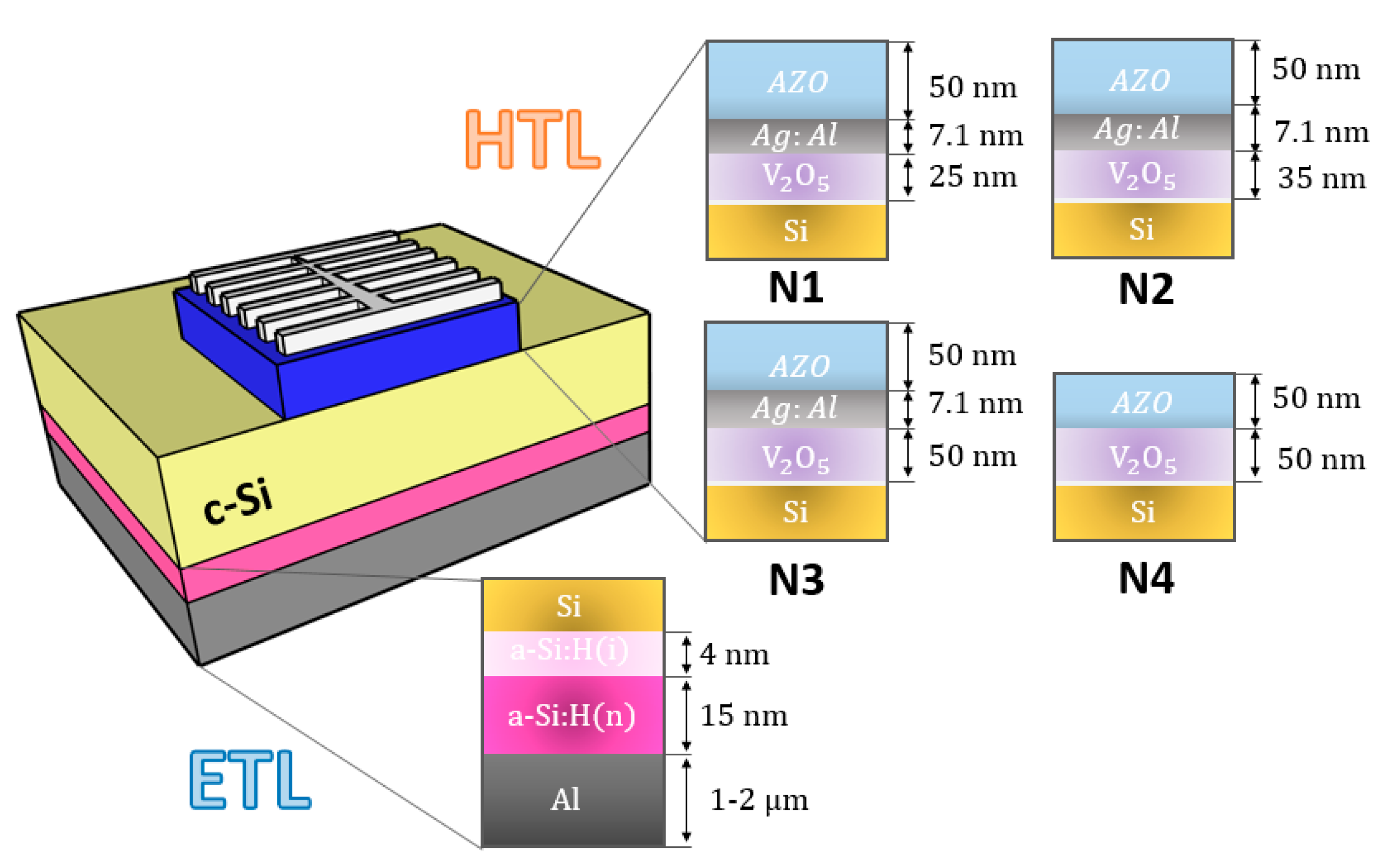

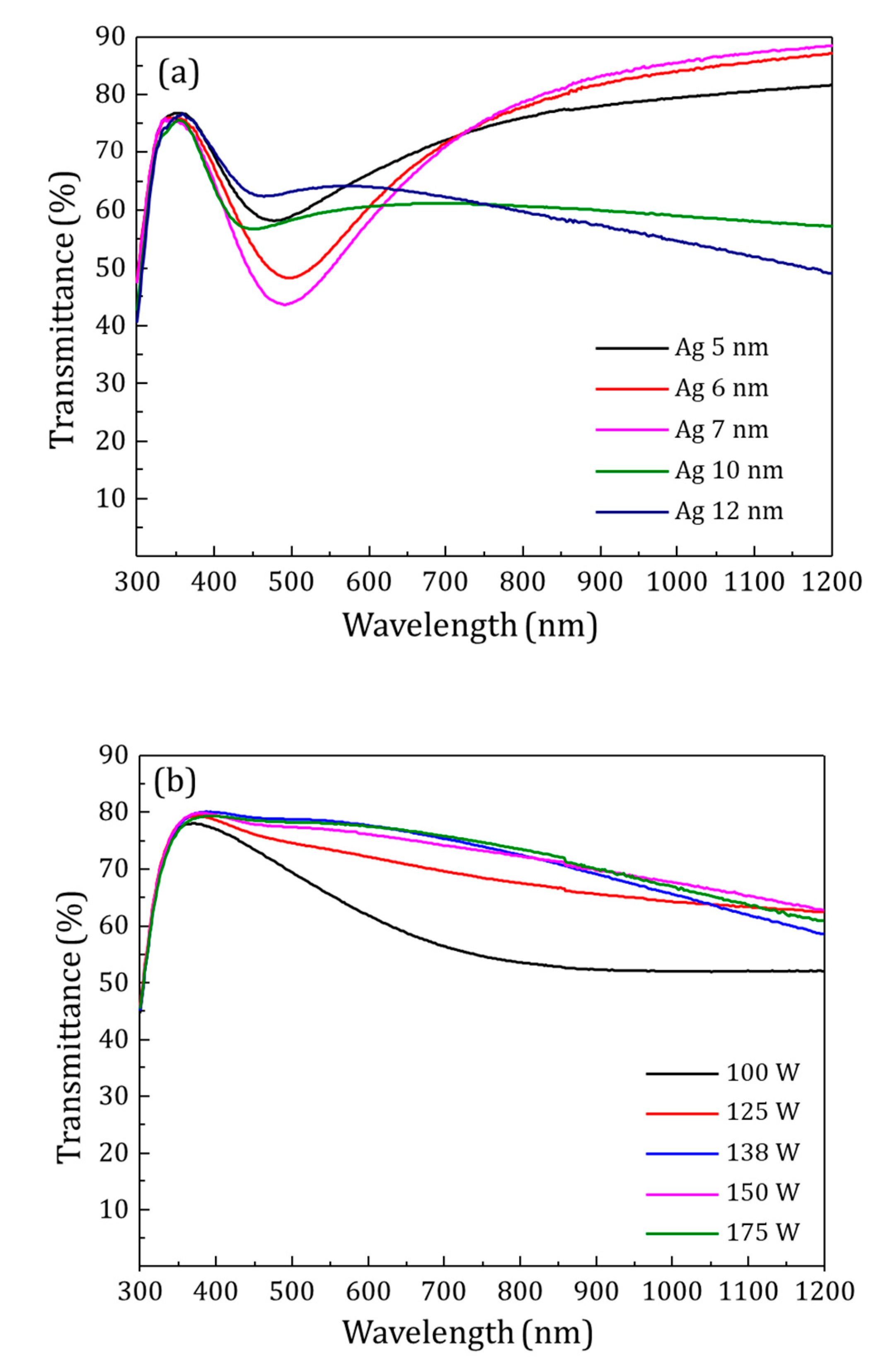
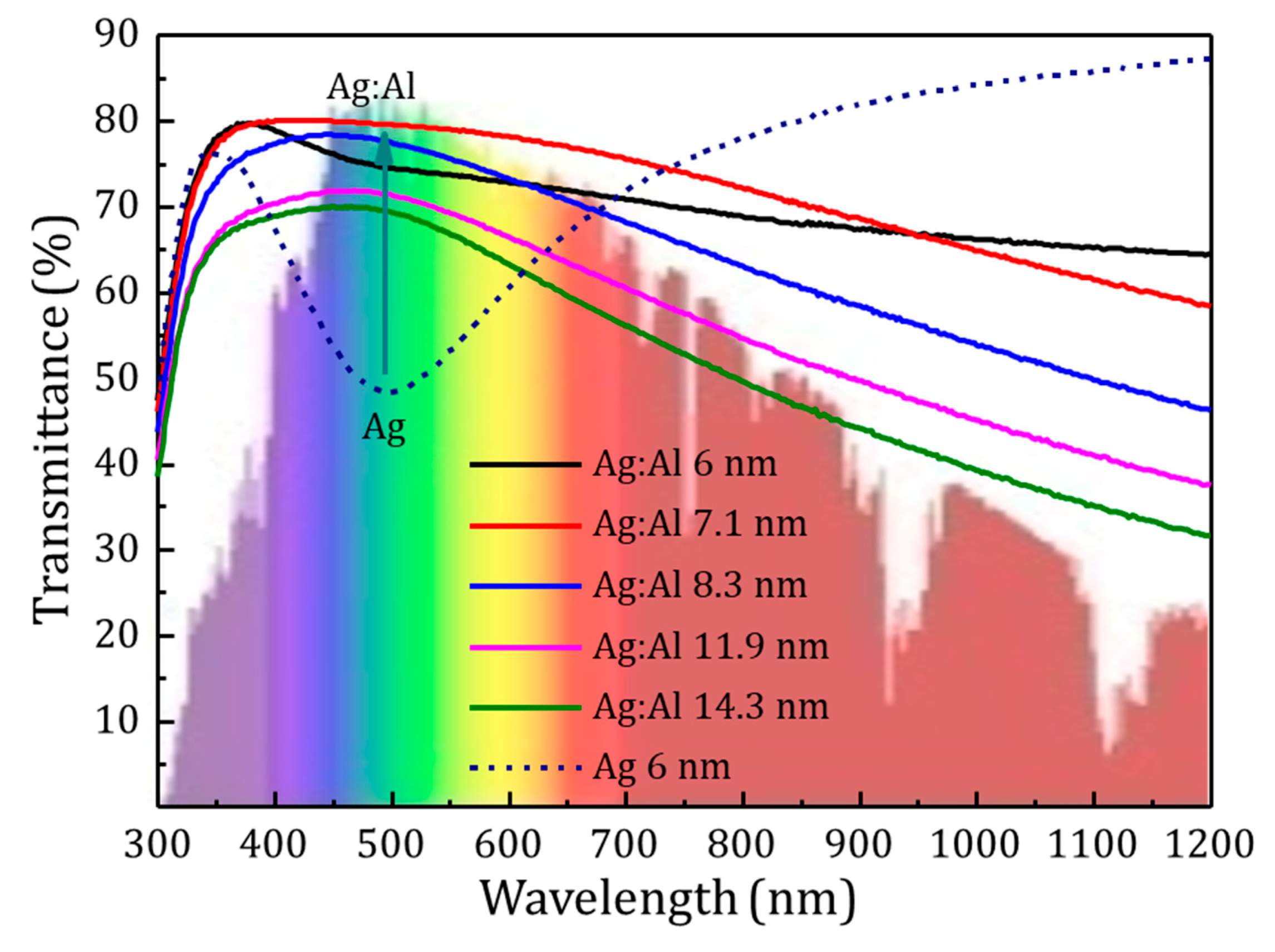
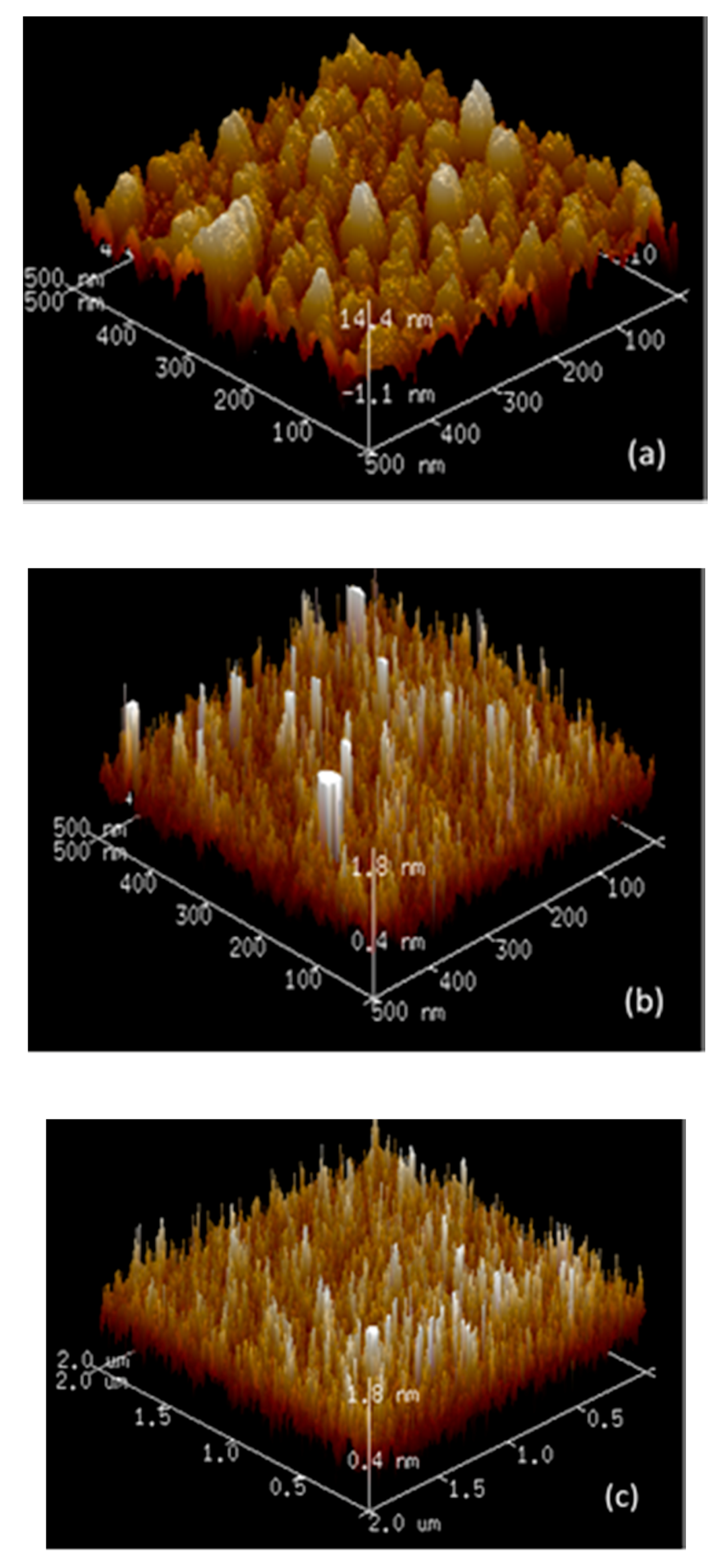
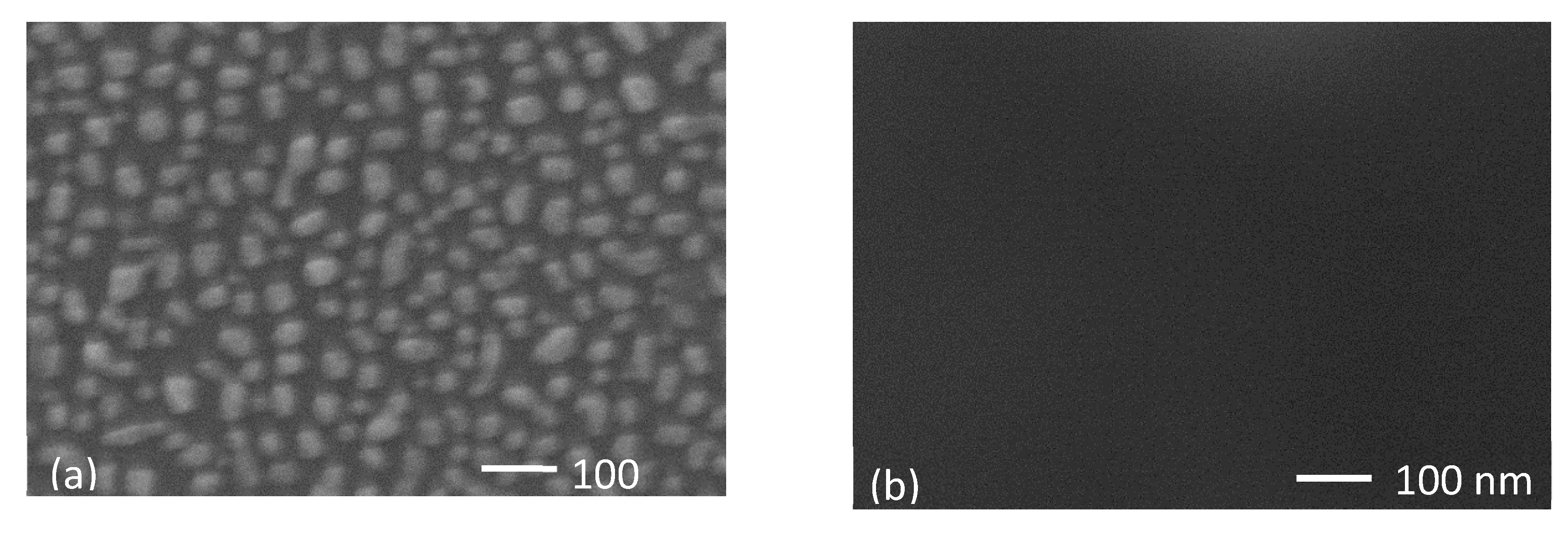


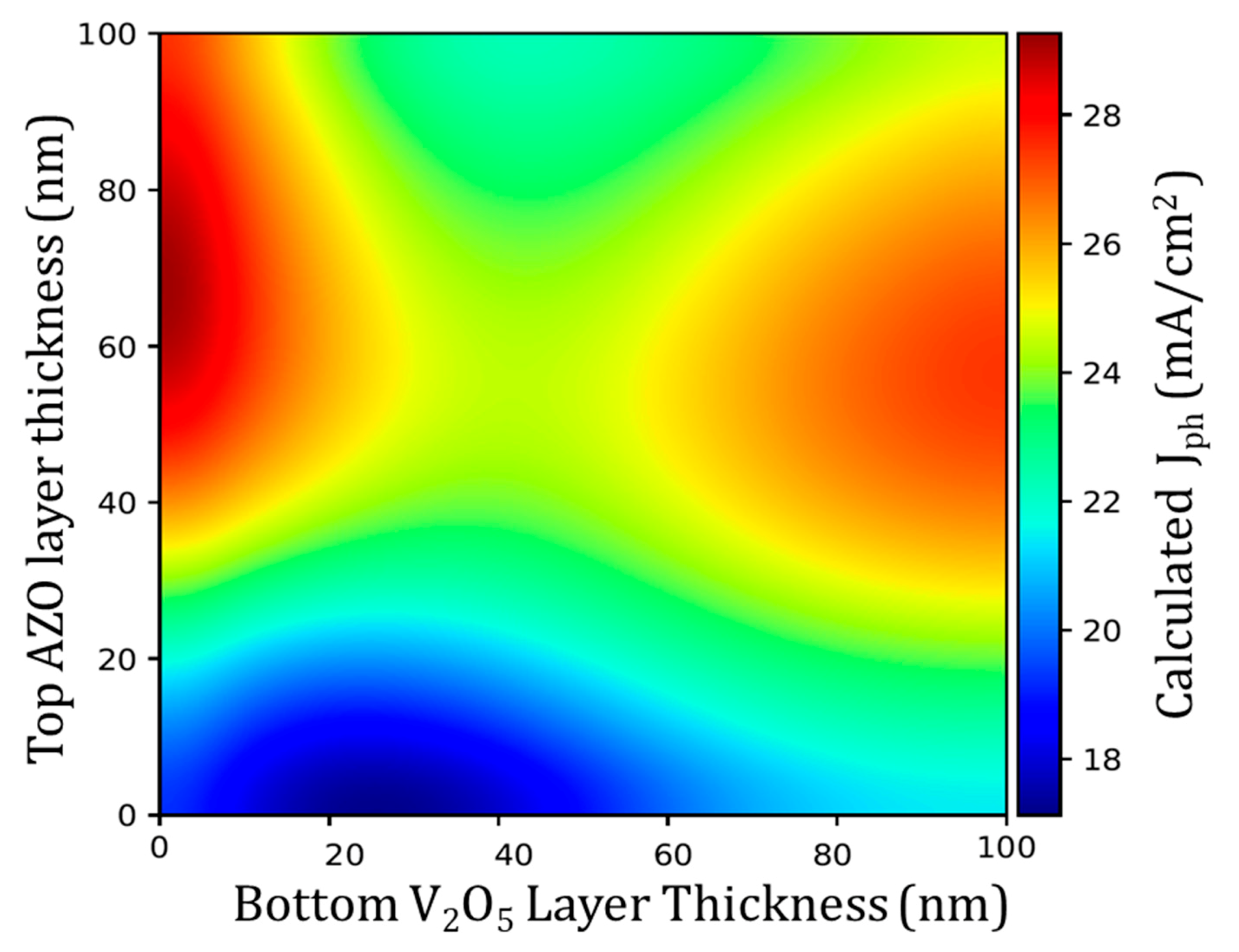
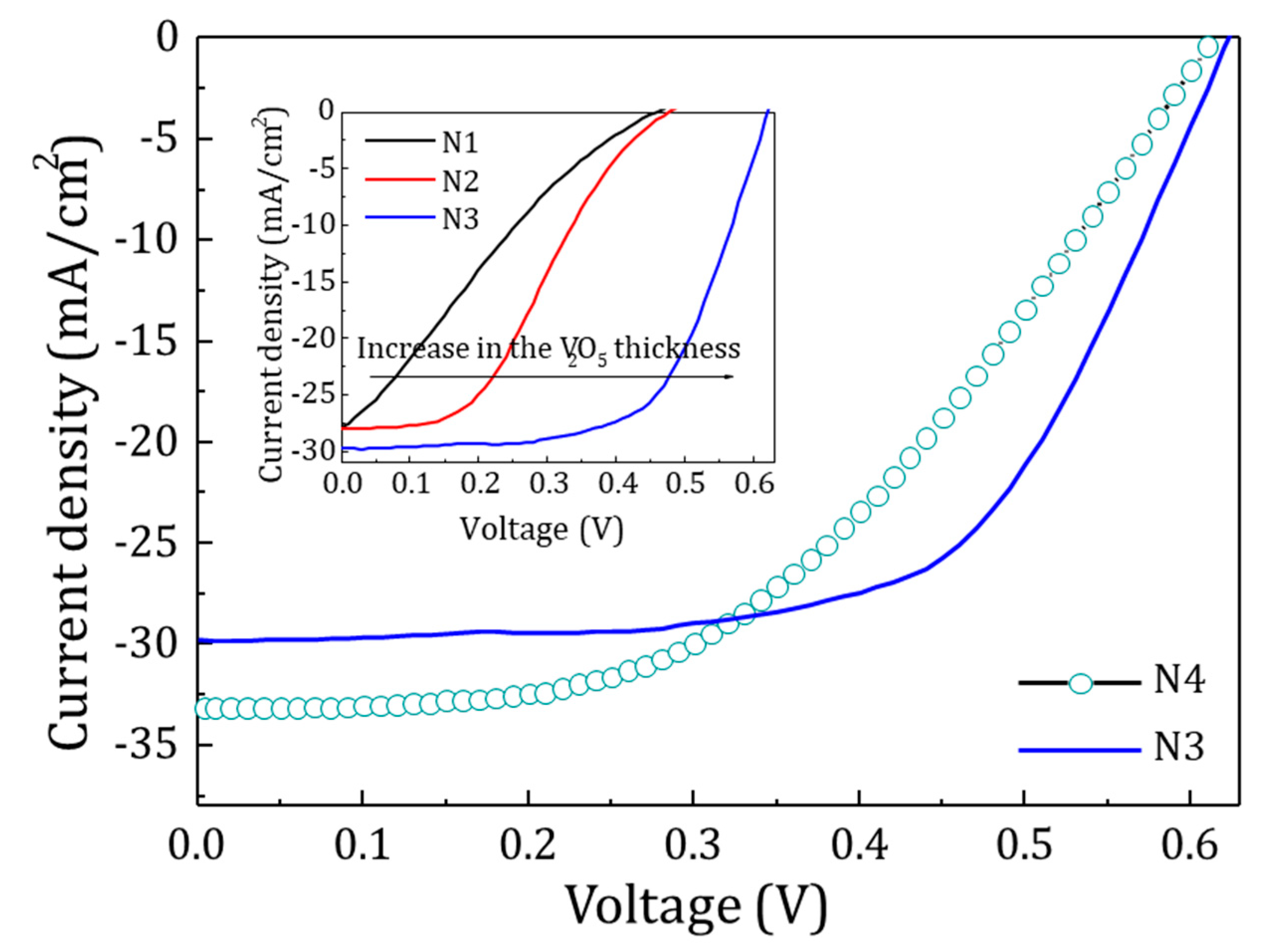
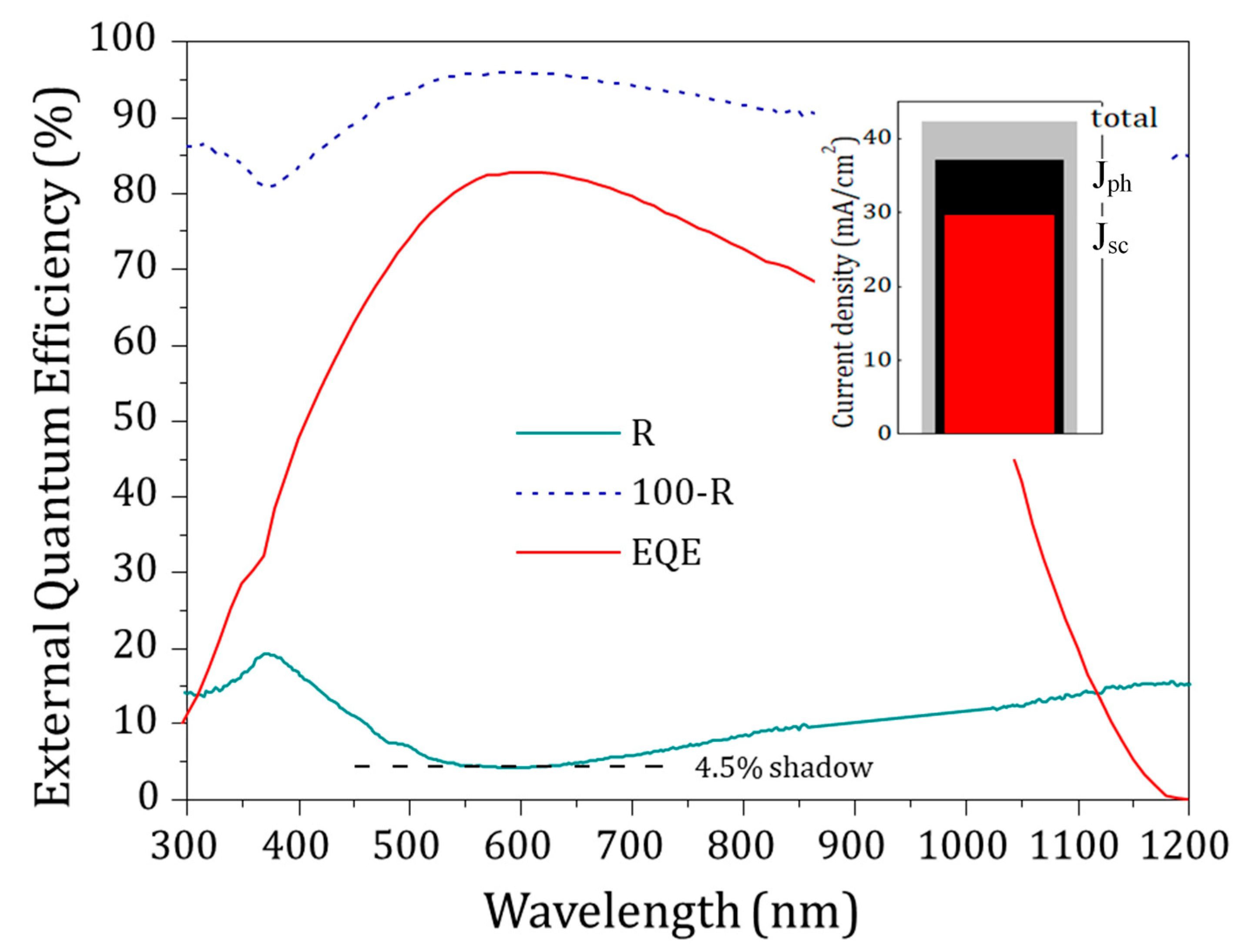
| Temperature (°C) | FOM (10−3Ω−1) | |
|---|---|---|
| AZO * | RT | 0.02 |
| AZO # | RT | 0.35 |
| AZO # | 100 | 1.4 |
| AZO#/Ag:Al *#/AZO# | RT | 1.9 |
| ITO * | 100 | 1.1 |
| N1 | N2 | N3 | N4 | |
|---|---|---|---|---|
| Voc (mV) | 459 ± 1 | 479 ± 1 | 631 ± 1 | 614 ± 1 |
| Jsc (mA/cm2) | 28.0 ± 0.2 | 28.1 ± 0.2 | 29.8 ± 0.2 | 33.1 ± 0.2 |
| FF (%) | 17.5 ± 0.5 | 38.6 ± 0.5 | 61.2 ± 0.5 | 47.5 ± 0.5 |
| η (%) | 2.2 ± 0.2 | 5.2 ± 0.2 | 11.5 ± 0.2 | 9.6 ± 0.2 |
Publisher’s Note: MDPI stays neutral with regard to jurisdictional claims in published maps and institutional affiliations. |
© 2020 by the authors. Licensee MDPI, Basel, Switzerland. This article is an open access article distributed under the terms and conditions of the Creative Commons Attribution (CC BY) license (http://creativecommons.org/licenses/by/4.0/).
Share and Cite
Tom, T.; Ros, E.; López-Pintó, N.; Miguel Asensi, J.; Andreu, J.; Bertomeu, J.; Puigdollers, J.; Voz, C. Influence of Co-Sputtered Ag:Al Ultra-Thin Layers in Transparent V2O5/Ag:Al/AZO Hole-Selective Electrodes for Silicon Solar Cells. Materials 2020, 13, 4905. https://doi.org/10.3390/ma13214905
Tom T, Ros E, López-Pintó N, Miguel Asensi J, Andreu J, Bertomeu J, Puigdollers J, Voz C. Influence of Co-Sputtered Ag:Al Ultra-Thin Layers in Transparent V2O5/Ag:Al/AZO Hole-Selective Electrodes for Silicon Solar Cells. Materials. 2020; 13(21):4905. https://doi.org/10.3390/ma13214905
Chicago/Turabian StyleTom, Thomas, Eloi Ros, Nicolau López-Pintó, José Miguel Asensi, Jordi Andreu, Joan Bertomeu, Joaquim Puigdollers, and Cristobal Voz. 2020. "Influence of Co-Sputtered Ag:Al Ultra-Thin Layers in Transparent V2O5/Ag:Al/AZO Hole-Selective Electrodes for Silicon Solar Cells" Materials 13, no. 21: 4905. https://doi.org/10.3390/ma13214905
APA StyleTom, T., Ros, E., López-Pintó, N., Miguel Asensi, J., Andreu, J., Bertomeu, J., Puigdollers, J., & Voz, C. (2020). Influence of Co-Sputtered Ag:Al Ultra-Thin Layers in Transparent V2O5/Ag:Al/AZO Hole-Selective Electrodes for Silicon Solar Cells. Materials, 13(21), 4905. https://doi.org/10.3390/ma13214905






